Ultra Dense Satellite-Enabled 6G Networks: Resource Optimization and Interference Management
Xiangnan Liu ,Haijun Zhang,* ,Min Sheng ,Wei Li ,Saba Al-Rubaye ,Keping Long
1 School of Computer&Communication Engineering,University of Science and Technology Beijing,Beijing 100083,China
2 Beijing Engineering and Technology Research Center for Convergence Networks and Ubiquitous Services,University of Science and Technology Beijing,Beijing 100083,China
3 School of Telecommunications Engineering,Xidian University,Xi’an 710071,China
4 State Radio Monitoring Center of China,Beijing 100037,China
5 School of Aerospace Transport and Manufacturing,Cranfield University,MK43 0AL,UK
*The corresponding author,email: haijunzhang@ieee.org
Abstract: With the evolution of the sixth generation(6G)mobile communication technology,ample attention has gone to the integrated terrestrial-satellite networks.This paper notes that four typical application scenarios of integrated terrestrial-satellite networks are integrated into ultra dense satellite-enabled 6G networks architecture.Then the subchannel and power allocation schemes for the downlink of the ultra dense satellite-enabled 6G heterogeneous networks are introduced.Satellite mobile edge computing (SMEC)with edge caching in three-layer heterogeneous networks serves to reduce the link traffic of networks.Furthermore,a scheme for interference management is presented,involving quality-of-service (QoS) and co-tier/cross-tier interference constraints.The simulation results show that the proposed schemes can significantly increase the total capacity of ultra dense satellite-enabled 6G heterogeneous networks.
Keywords: satellite-enabled 6G networks;network architecture;resource optimization;interference management
I.INTRODUCTION
As the next generation mobile networks develop,new challenges and requirements arise from the surge of transmission traffic.The sixth generation (6G) wireless system will break through the limitation of terrain and thereby realize ubiquitous connection by a whole-earth coverage[1].Many novel enabling technologies are initiated,such as terahertz communication [2],intelligent reflecting surface [3],and federated learning [4],etc.In the context of these state-of-the-art technologies,the integrated terrestrialsatellite networks can provide various benefits including a larger capacity of wideband transmission and a wider coverage area.Therefore,integrated terrestriasatellite networks incorporating the relatively independent satellite networks into terrestrial cellular networks becomes a trend.As an integral whole of satellite networks and the terrestrial networks,integrated terrestrial-satellite networks provide globally seamless,ubiquitous services accessible to Internet[5].
In the past two decades,human beings have always been trying to realize the construction of the integrated terrestrial-satellite networks [6–9].In the end of the 20th century,Motorola proposed a satellite communication network plan named“Iridium Project”[10].It can be regarded as an endeavor to support the globally wireless communications among different ground stations by means of the satellites.Unfortunately,the project ahead of its time failed because of costly expenses and a limited number of initial user terminals.However,recent advances in low earth orbit (LEO)satellite networks over the high-frequency band have provided an alternative solution for coverage extension and backhaul connectivity.SpaceX,this famous LEO satellite company planed to launch circa 12,000 Starlink Internet satellites would dominate the lower part of the Earth orbit,below 600 km [11].To obtain more communication resources,the United States,Europe,and China have accelerated the deployment of LEO satellites to support communications of integrated terrestrial-satellite networks.
Motivated by the rapid development of integrated terrestrial-satellite networks deployment,the academics and industries focused on the research emphases below,including access control,dynamic backhaul links,multicast protocols,offloading of mobile edge computing (MEC) [12],software-defined networking(SDN)[13],network functions virtualization control [14],as well as coordination of high and low orbit satellites,etc.The broadcast and multicast function of LEO satellites ensures tasks of ground user terminals to be processed by MEC servers[12].The ultra dense networks are densely deployed to satisfy the dramatically increasing traffic demands [15].Based on this technique,researchers have established a theoretical model of a ultra dense LEO terrestrial-satellite networks,in which LEO-based small cell have better performance on data offloading as the traffic load increases [16].Network functionalities over satellite networks have been researched actively.With the absence of a proximal MEC server,each user terminal in satellite-terrestrial integrated networks can also experience MEC services via satellite links[17].As for dealing with the interference between Geostationary(GSO) satellites and LEO satellites,the popular solutions,such as the progressive pitch method and the coverage-expanding method,underpin the same principle,which is to transfer the interference to neighbor satellites before the host satellite turns off[18].
Nowadays,with the deeper integration of communication,computing,storage resources in mobile communication network,the resource allocation in satellite-terrestrial integrated networks is no longer limited to a single domain of communication resources.The work in [16] considers the optimization of user associations,sub-channel allocation and power control in the ultra-dense LEO networks.This work in [19] begins to extend from the communications domain to the caching deployment based on the consideration of popularity.The work in[20]considers the joint allocation of resources for the communication domain,the cache domain,and the computing domain,and proposes a deep Q learning method to explore the maximum reward.The authors focus on the allocation of resources in three areas in the context of throughput equity and data security [21].However,These current efforts all involves the three-domain resources of a single LEO satellite,and there is still little research on the heterogeneous ultra-dense satellite networks.
On the other hand,the interference management of ultra-dense heterogeneous networks is also worth of to be studied.In [22],power is allocated with interference constraint to achieve interference management purposes,taking into account energy efficiency.Interference management is achieved through power control,and the data rate of the interference signal is lower than that of quality of service (QoS) constraint[23,24].It can be seen that it is feasible to establish interference management for the satellite-terrestrial integrated networks on the scheme of resource management.
Motivated by the related works,we investigate the subchannel allocation and power control in the communication domain.Besides,the SMEC and caching deployment are designed in the heterogeneous ultradense satellite networks.Under the scheme of resource optimization,the interference management cooperated with cognitive radio is trailed in the heterogeneous ultra-dense satellite networks.
Different from the existing studies of satellite enabled networks,the paper focuses on the downlink of wireless communications heterogeneous networks with LEO and GSO satellites.On this basis,resource optimization and interference management are explored by utilizing edge caching and analyzing different kinds of interference is demonstrated first..An architecture of ultra dense satellite-enabled 6G heterogeneous networks.Then an effective algorithm of resource allocation is designed in the satellite enabled 6G networks to promote the total capacity of networks.Furthermore,the network interference and the strategy of interference management are analyzed.Finally,conclusions grounded on the simulation results put final touches to the paper.
II.ULTRA DENSE SATELLITE-ENABLED 6G NETWORKS ARCHITECTURE
It is viable that the ultra dense satellite-enabled 6G heterogeneous networks productively utilize satellites in a full range of orbits to scale up their capacity.Through the inter-satellite link and ground-satellite one,the communication terminals on the ground,in the sea,air or deep space are intensively integrated.Satellites are able to handle complex communication environments,such as crowded urban areas where space is limited or sea areas where gateways are difficult to be deployed.It can be either on-demand integration of the existing satellite systems or the result of integrated design according to requirements.
Based on the analysis of application scenarios,Figure 1 depicts the architecture of satellite enabled 6G heterogeneous networks.This architecture displays two major sorts,ground-based one and space-based one.The focal point of the ground-space communication is on the space segments,for it can save redundant costs with participation of the ground gateway.The subnetwork mentioned above consists of satellites which access user terminals to the space.The emphases of future research on profoundly integrated ground-space networks are not only the communication itself but also the computing and storage.What needs to be considered is multi-dimensional resource management and allocation.The paper studies the space-based subnetworks and LEO satellites supportive of terrestrial communication as well as GSO satellites gathering information of space-based subnetworks and transmitting the control signal between two subnetworks,and four application aspects discussed as below.
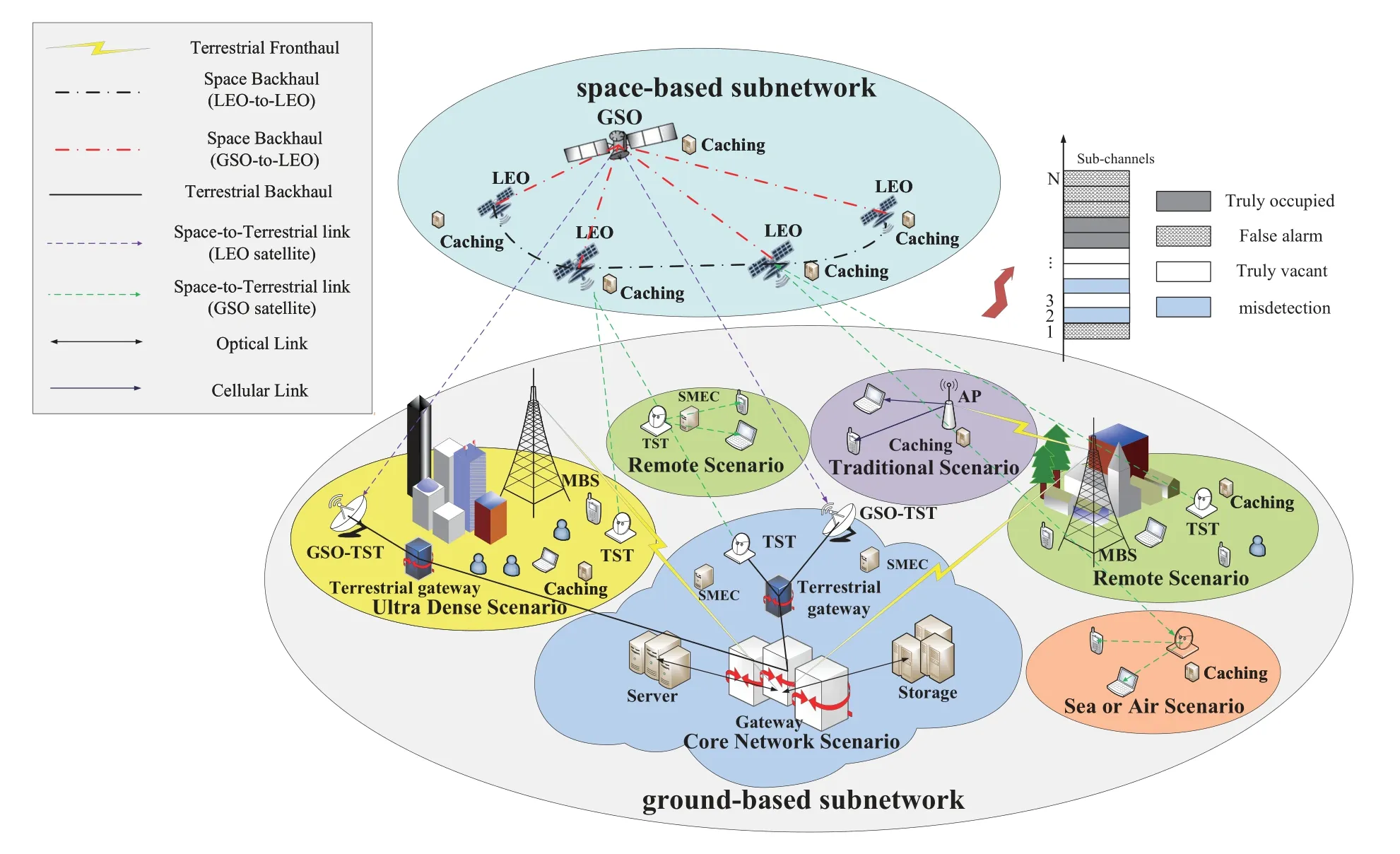
Figure 1.An architecture of ultra dense satellite-enabled 6G heterogeneous networks.
2.1 The Aspect of Core Networks
Given that not all data can be computed in the local network,certain tasks call for more storage and servers.Moreover,numerous videos,files and images should be stored in core networks.So the terrestrial gateway stations(TGSs)should be set to connect core networks,i.e.a cellular network,a cloud center or a regional IP network.Once equipped with powerful directional antennas,TGSs can sustain the operation of multiple user terminals.
2.2 The Aspect of Metropolitan Areas
There are plenty of user terminals in the metropolises where colleges or corporations stand.An essential prerequisite for this case in which the deployment of a few TGSs and enough terrestrial satellite terminals(TSTs) is the terrestrial stations equipped with more powerful antennas.Compared to TGSs,TSTs’ antenna is not powerful and can relay data for a small group of user terminals.Since habitats of human beings are vastly at middle and low latitudes,LEO and GSO satellites are the agents of relay service.
2.3 The Aspect of Remote Areas
There are still some user requirements in the remote ground area,such as villages,isolated islands or mountainous areas.The remote areas include sparsely populated rural areas and mountainous areas.Without specific latitudinal constraints,the services from LEO satellite sites at any latitude are deliverable[25].Considering the limited user terminals and infrastructure costs,one TST is apportioned in one region.In some circumstances,UAVs are deployed to cope with an upsurge in requests in case of some events.
2.4 The Aspects of Seas or Air
Unlike the aspects above,communication,computation,and storage capacities of user terminals are considerably limited when the user terminals are served in the seas or air,because the base stations are difficult to deploy.The sea and air are deployed the base stations difficultly.These scenarios are not like lowerdense population in seas and air and have to support hotspot coverage.Meanwhile,aircraft and ships in motion ramp up the difficulty level of designing the ultra dense satellite-enabled networks.The antennas with lower power embed in the vehicles.There should be a compromise between the cost of antennas and user terminals.
As shown in Figure 1,each satellite with caching can promote the performance of the entire networks.In face of the system capacity impacted by constantlymoving satellites,the multi-layer caching is employed to deal with the demands of the real-time service from terrestrial user terminals.In this case,each access point (AP) receives the same data request,with direct response to the source server.Therefore,repetitive transmission of content and spares excess traffic is avoided,which upgrades the service quality of the networks.Meanwhile,each satellite has an ability to recognize,especially imperfect spectrum information resulting from long propagation delay in space.
In the following two sections,resource optimization is formulated as an capacity maximization for the downlink of ultra dense satellite-enabled heterogeneous networks.The case aims to maximize the capacity of entire networks through resource allocation,which facilitates researchers and operators to observe the performances of the following algorithms.With reference to interference management,cognitive satellites are obtained in the proposed architecture.Spontaneously,interference from other satellites is managed.
III.RESOURCE ALLOCATION SCHEME IN ULTRA DENSE SATELLITEENABLED 6G NETWORKS
This section focuses on the subchannel allocation and power control in the ultra dense satellite-enabled heterogeneous networks,where the coverage of one GSO satellite overlaps that of spectrum-sharing LEO satellites.Heterogeneous QoS requirements for user terminals is a key indicator in the scheme.The capacity of networks is also influenced by the sets of caching and strategies of adjustment.
3.1 Subchannel Allocation and Power Control
According to the International Telecommunication Union (ITU)’s regulation [26],the communication of GSO satellites processes prior to the LEO ones.GSO satellites may pose some potential problems,specifically interference and resource contention.A common and empirical solution is turning off the LEO satellites that block the links of GSO satellites,and other LEO satellites act as supplements [18].In the proposed heterogeneous networks,user terminals can receive miscellaneous signals from the LEO satellites and even from some remoter GSO ones simultaneously.When involved in the downlink of ultra dense satellite-enabled heterogeneous networks,a primary GSO satellite acts as the AP.It is different from those LEO satellites which are denoted as a set of small cells.Each LEO satellite hosts one small AP andUuser terminals that are randomly distributed within the LEO’s terrestrial reference point.To be exact,the terrestrial reference points of LEO satellites upright projections on the surface of the earth.The total bandwidth of the system is denoted asB,which is divided intoQsubchannels and each subchannel occupies a bandwidth ofB/Q.The LEO satellites transmit signals toUuser terminals through theseQsubchannels.
LetPs1andPs2represent the power budget for the GSO satellites and LEO satellites respectively,assuming that all the LEO satellites have transmit powerPs2and each user terminal of LEO satellites has initial transmit powerPs2/Q.The earth-satellite links are much shorter,which results in lower power [27].The power budget of GSOPs1should be higher than LEO’sPs2.A block fading channel is considered in the system model,where the channel fading of each sub-carrier is assumed to be the same within a subband,but it varies independently across different subbands.It is obvious that user terminals also receive other LEO satellites’ and GSO satellites’ signals,resulting in the unnecessary interference.
Derived from Lutz’s model[28],the principle is utilized to model the link of land mobile satellite.The channel fading of each subchannel is designed in two types.One is composed of large-scale fading and Rayleigh fading.The other one is composed of largescale fading and Rician fading.In this model,the channel gain is classified into two types,the better one is applied by Rician fading,and while the worse one works with Rayleigh fading.It is hypothesized that the user terminals that the satellites supported in its coverage area would obtain the Rician fading,or else the signal from other satellites would go through with Rayleigh fading.We denotehm,n,qas the channel state between them-th satellite and then-th user terminal in theq-th subchannel.
Let the binary matrix X∈RM×N×Qdenote the subchannel indication matrix,and whenxm,n,q=1,it means theq-th subchannel is assigned ton-th user terminal served by them-th LEO satellite,otherwisexm,n,q=0.The P∈RM×N×Qis the power allocation matrix ofMLEO satellites.After setting these two matrices with channel gain on subchannel from LEO satellites to user terminals,the received signalinterference-noise-ratio(SINR)is obtained.Thus,the downlink capacity on theq-th subchannel of then-th user terminal in them-th LEO satellite can be calculated by the received SINR at them-th LEO satellite for then-th user terminal occupying theq-th subchannel via Shannon’s formula[15].
The mathematical expression of uplink transmission capacity is given as the Eq.(1).Theis denoted as the antenna gain of satellitemtowards satellitenandis the off-axis antenna gain of satellitem′towards the direction of user terminaln.Theσ2represents the additive white Gaussian noise.In the designed constraints,constraintC1 implies the transmit power constraint,wherePmaxis the maximum transmit power of each satellite.As it is typical for the orthogonal use of frequency resources within each satellite,which is guaranteed by constraintC2.The angle constraint can then be denoted as constraintC3.θthis defined as the angular separation between satellites.ConstraintC4 ensures the QoS guarantee of each user terminal.ConstraintsC5 andC6 are added,based on the features of subchannel allocation factorxm,n,qand power control factorpm,n,q.The constraints in resource optimization are listed as
In this case,the resource optimization is formulated into a mixed integer of non-convex programming issue.Next,the Lagrange dual decomposition approach[29] is an solution to such technical difficulties as joint subchannel allocation and power control.The resource allocation is formulated into the following.
The user terminals’ QoS constraint requires the maximal capacity of user terminals in theMLEO satellites with the assistance of the proposed allocation resource scheme.And for brevity,is defined asxm,n,qpm,n,q.Then,the downlink of capacity maximization is treated as a mixed integer of non-convex programming with all constraints.
And the Lagrangian dual function is defined as
The Lagrangian dual function in Eq.(4)can be decomposed into a master problem andM×Qsubproblems.
where
Utilizing the Karush-Kuhn-Tucker conditions,the optimal solutions of the subproblems can be obtained.
It can be seen that the partial derivative of subchannel scheduling factorxm,n,qis expressed as
where
Through Eq.(11),the subchannel allocation can be realized.After obtaining the subchannel allocation,the power control can be optimized through the subgradient method,
where[x]+=max(0,x).Through Eq.(13),the optimal power control factor is also calculated.The master dual problem can be solved as
3.2 Satellite MEC Scheduling
Aiming at improving the user terminals’QoS and reduce traffic volume in the space-air-ground-integrated networks,satellite mobile edge computing(SMEC)is applied to the satellites.Four deployment schemes of SMEC [17] are no edge computing,proximal terrestrial offloading(PTO),satellite offloading(SBO),and remote terrestrial offloading(RTO).Although the PTO decreases latency from long backhaul substantially,its high cost fails to deploy remote areas.SBO is also not economically viable,which characterizes SMEC embedded in LEO satellites.In addition,it will significantly increase its power consumption.Compared with PTO and SBO,RTO is more practical for the implementation of MEC.In this scheme,SMEC servers will be deployed in gateways which connect the Internet.The deployment of SMEC servers is an important consideration if cost and transmission delay arrive at an equilibrium.
The functions of SMEC can be divided into computing offloading and caching deployment,aiming to reduce the traffic burden of space-to-terrestrial links.Thus,the effort of SMEC with caching is responsive effectively to variable situations.All LEO satellites and ground stations are equipped with local caching,which constitutes cooperation of two-layer caching deployment.The deployment of MEC servers in the ultra dense network enables power-sufficient gateways to connect to core networks.
To evaluate the relationship computing offloading and caching deployment,a popularity-based caching policy is denoted as the request probability for a computing taskd∈sm,nas follows:
δindicates the popularity profile.Through the popularity analysis of each user terminaln,the alleviation of backhaul bandwidth can be given by
Ymis the storage limitation of each LEO satellitemandsm,ndenote user terminaln’s content size.
Different from the caching case of ground stations which respond to the request from its serviced user terminals immediately,the caching case of satellites takes advantage of their broadcast property.The satellite receives the requests of users in their present footprint at a certain time.On completion of the request collection,the satellites communicate with their local cache,and continues to transmit a few requests to the gateways for data generation or information collection on the Internet.Binary variables represent the connection between the LEO satellite and its user terminal on a certain subchannel.And the requests for content from user terminals follow Zipf distribution [30,31].As it is shown in Figure 2,the caching deployment is divided into three stages.In the preliminary stage,the required content of user terminals has been completely cached in the local LEO-TST,so the local caching can satisfy the demand of user terminals.If that was not the case,the requests for content would be sent to the current LEO satellite.In the second stage,the satellites will broadcast the local content to its footprint,and send unfulfilled requests to GSO satellites.Then,In the third stage,the requests will be transmitted to the gateway with SMEC,and the complex tasks will be transferred to the core networks.The scheme of caching helps alleviate the overloaded traffic and enhance the overall capacity.
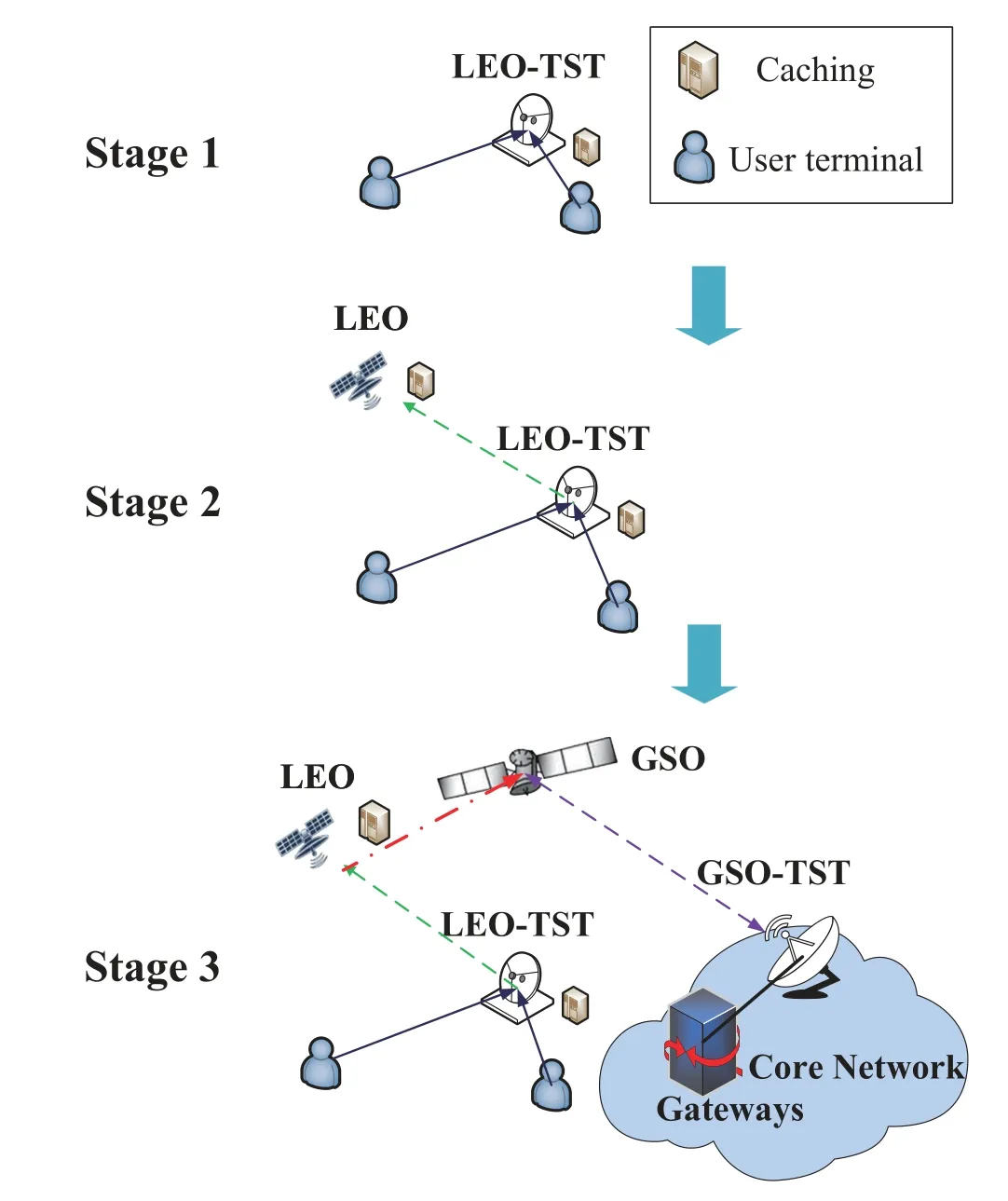
Figure 2.The procedures of caching deployment in SMEC.
The caching deployment can be controlled by the binary parameterym,n.If LEO satellitemcached local data of user terminaln,the caching deployment factorym,nequals 1.
An algorithm of distributed joint subchannel allocation and power control is devised.Besides,the caching deployment is also included in the resource allocation scheme.The procedure of resource allocation is presented in Figure 3.Figure 3 illustrates procedures of resource optimization including subchannel allocation,power control,and caching deployment in the architecture.Firstly,each user terminal occupies only one subchannel and obtains equal power.Then the number of iterationsTmaxand Lagrangian variables vectors{λ,µ,υ}are initialized.Each LEO satellite deploys the caching via popular analysis.Subsequently,the algorithm does not stop iteration until the convergence or reaches toTmax.During the loop,the subchannel scheduling factorxm,n,qand power control factorpm,n,qupdates by Eq.(11) and Eq.(13),respectively.Lagrangian variables vectors{λ,µ,υ}updated by Eq.(14) and Eq.(15).And then the capacity of the whole network systems is calculated.If the total capacity of the networks convergence,the algorithm terminates and jumps out of this loop.The resource optimization and its corresponding solution are obtained.The simulation results and discussion section scrutinizes and expounds the results of the proposed algorithms via simulation results.
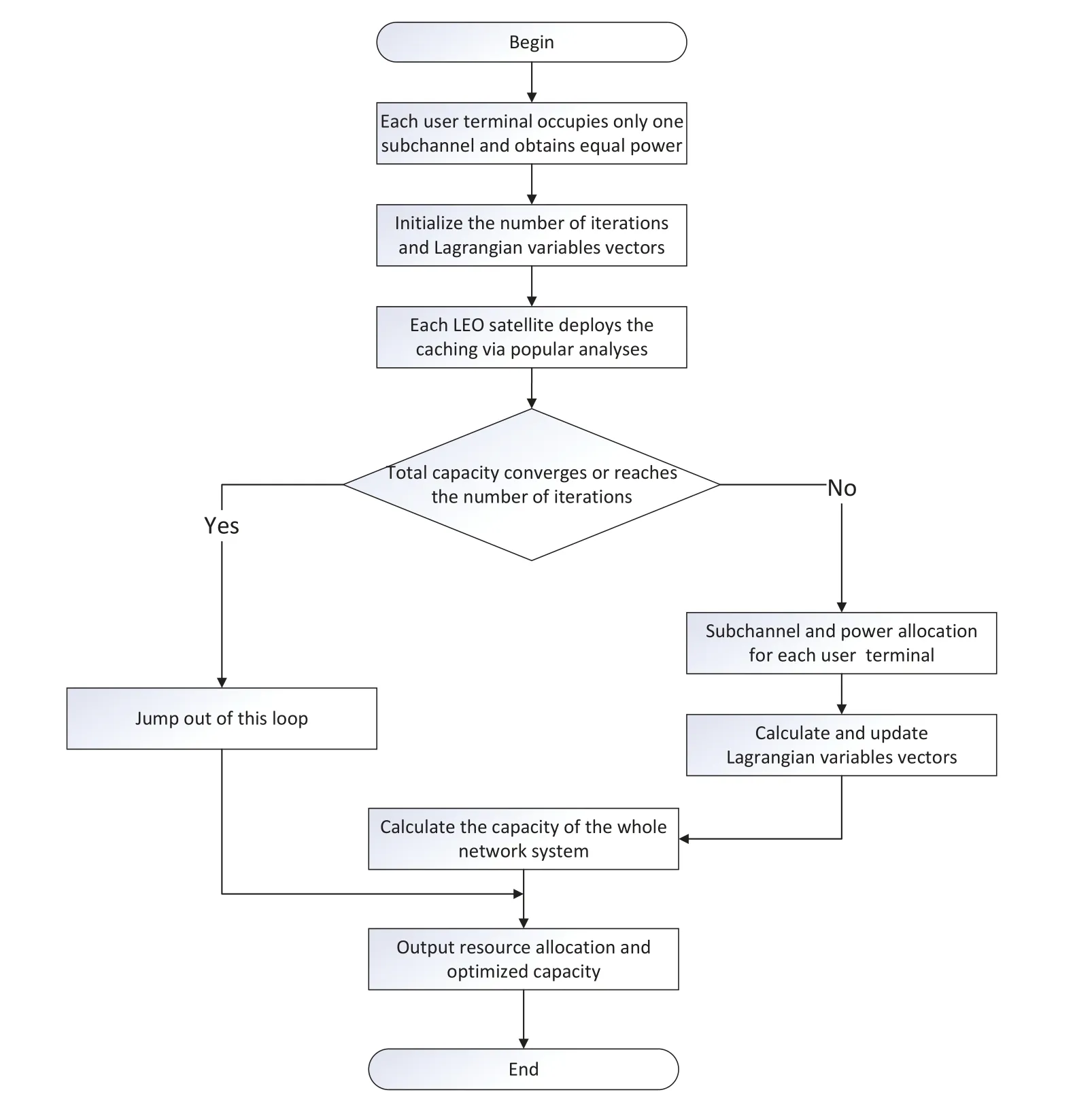
Figure 3.The procedures of resource optimization.
IV.INTERFERENCE MANAGEMENT SCHEME IN ULTRA DENSE SATELLITE-ENABLED 6G NETWORKS
To mitigate the spectrum scarcity,the cognitive terrestrial-satellite networks have been emerged as one of promising approaches.This technique can be regarded as the extension of cognitive radio in terrestrial-satellite networks,where the primary networks share spectrum with secondary networks.The users in these two networks are considered as the primary users (PUs) and secondary users (SUs).The functions of the cognitive integrated terrestrialsatellite networks are spectrum awareness and spectrum exploitation.Spectrum awareness obtains relevant information of the surroundings,and spectrum exploitation distributes the available resources optimally among the SUs[32].
At present,the academics and industries mainly pay attention to the spectrum reuse of satellite and terrestrial networks.In this paper,cognitive integrated terrestrial-satellite networks equip the LEO satellites with spectrum sensing.Each LEO satellite makes decisions to judge whether or not the subchannels are vacant via the information of spectrum awareness.Due to long latency or estimation errors,it is difficult to achieve perfect spectrum sensing of downlink of cognitive integrated terrestrial-satellite networks.In addition,compared with the certain decay in GSO satellites,the Doppler shifts [12] will also aggravate the complexity of obtaining the perfect spectrum information.In this imperfect situation,the interference power constraint can not guarantee the QoS of PUs.
Based on the discussion above,the imperfect spectrum sensing of LEO satellites may lead to severe cotier and cross-tier interference in the whole system,which is from other LEO satellites and from remote GSO satellites respectively.The cross-tier interference will be influenced by two cases.andare introduced to symbolize the hypothesis of subchannelq’s occupation and vacant by the GSO satellite,respectively.Andis denoted as the real result of subchannelq’s occupation.A situation that the determination is occupied while a subchannel is vacant in a primary network is called false alarm.The false alarm probability Pris calculated as
Accordingly,A situation that the determination is occupied while a subchannel is occupied in a primary network is defined as a correct detection.This situationis calculated as
Thus,a probabilistic approach with the transmitted powerPsis adopted,and thePsequals minimum among the quotient of pre-calculated interference power constraint divided by the channel gain of interference links and the maximum allowable transmit power.
Based on the above analysis,the constraintC7 is presented to limit the cross-layer interference from GSO satellites.We denoteas the cross-layer interference temperature threshold and the constraint is given by
Besides,the co-tier interference form neighboring LEO satellites is also considered.Similar tothe co-tier interference limit is denoted as.
These two constraintsC7 andC8 discussed above added to the proposed algorithm of resource allocation,there are two Lagrangian multiplier vectors correspondingly.Meanwhile,comprehensive utilization of all subchannels boosts the total capacity of the networks.
V.SIMULATION RESULTS AND DISCUSSIONS
In this section,simulation results and discussion are presented.The simulation environment is deployed in Matlab 2019.The number of LEO satellites ranges from 1 to 30.The bandwidthBequals to 10 MHz.The initial transmit power of LEO satellitesPs1equals 14.3 dBW[33],and that of GSO satellitesPs2is 15.2 dBW[34].The height of LEO satellite and GSO satellite are set as 1,000 km and 36,000 km,respectively.
Figure 4 shows the total capacity versus the number of LEO satellite’s user terminals.As it shows in Figure 4,the total capacity increases when the number of the LEO satellite’s user terminals grows.The comparison between “with ultra-dense satellite” and“without ultra-dense satellite”have been added in Figure 4.There are 30 LEO satellites deployed in scenario“with ultra-dense satellite”and 3 LEO satellites deployed in scenario“without ultra-dense satellite”.It can be seen that the proposed method is superior to the current QoS-guarantee method.Through both of performances of two methods,“with ultra-dense satellite”quite obtained more capacity in the total systems.It can ensure the higher rate requirement in the satelliteenabled 6G networks.
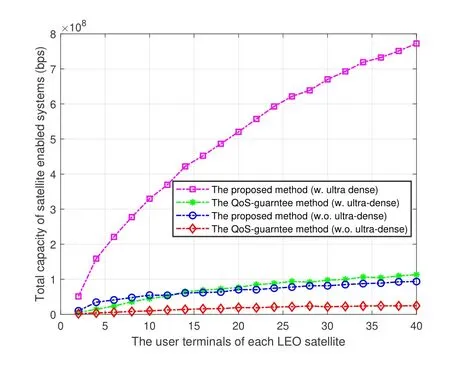
Figure 4.Total capacity vs. the number of user terminals of LEO satellites.
However,Figure 5 illustrates the total capacity versus the number of the LEO satellites.The number ofLEO satellites’user terminals is 10.In terms of spectrum efficiency,interior-point-method power control is compared with the proposed method and the QoSguarantee method,in which the MAX-SINR algorithm[35] allocates subchannels.Figure 5 suggests that better spectrum efficiency is more achievable by the proposed Lagrangian dual decomposition method than interior-point method or the QoS-guarantee method.It is obvious that the proposed Lagrangian dual decomposition method is superior to the QoS-guarantee method according to Figure 4 and Figure 5.Thus,the proposed method is more applicable to the networks,on the premise that algorithm complexity is less involved in the scheme.
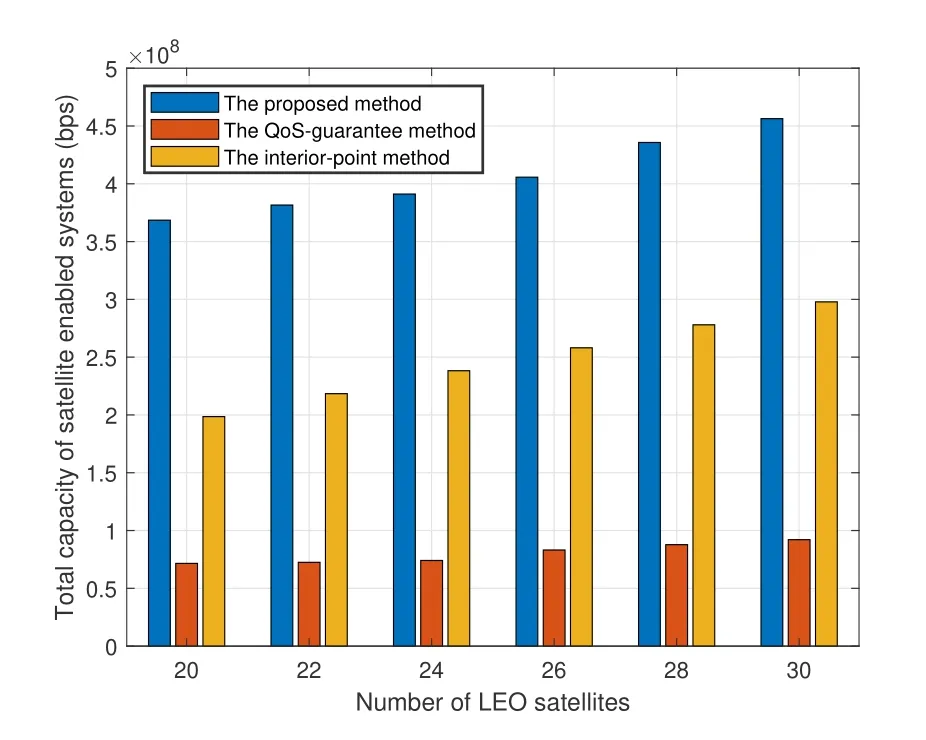
Figure 5.Total capacity vs. the number of LEO satellites.
Figure 6 shows the total capacity versus the number of LEO satellites,comparing the mentioned four typical application simulation results.The different simulation features are listed in Table 1.Owing to the adequate computation and storage performance,the core networks do not require the caching deployment.On the other hand,the aspects of remote areas is so sparsely populated that caching deployment is unnecessary.The main difference between the aspects of remote areas and the aspects of seas or air depends on the density of terminals.The number of LEO satellites’user terminals is set as 100 in the aspects of core networks and the aspects of metropolitan areas.Nevertheless,the number of LEO satellites’user terminals is set as 10 in the aspects of remote areas and 30 in the aspects of seas or air.The caching deployment is added in the aspects of core networks and the aspects of seas or air.The popularity profileδis set as 1 in Eq.(16).It can be seen that the aspects of core networks do not need too high backhaul capacity because of the predominant performance of computing and storage.Meanwhile,the aspect of remote areas also do not need the backhaul capacity because of the sparse population.On the contrary,the aspects of metropolitan areas acquire higher capacity due to the dense user terminals,seas or air as well.

Table 1.The differences in four typical application scenarios.
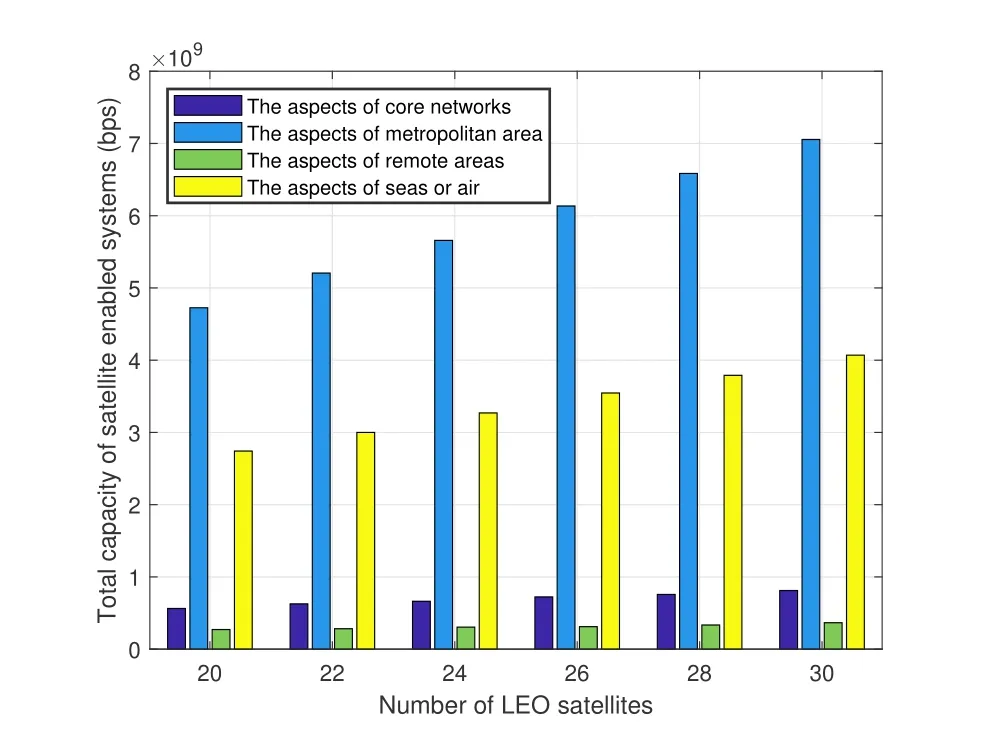
Figure 6.Total capacity vs. the number of LEO satellites.
Figure 7 shows cross-tier interference from GSO satellite to user terminals when the maximal transmit power of per LEO satellitePs2increases from 10 dBW to 20 dBW.The simulation parameters are set asM=10 andN=10.The QoS-guarantee method and the equal-power method are introduced to compared with the proposed method.Different from the referred methods,the proposed method obtains the decrease of cross-tier interference with the gradual increase of the maximal transmit power of per LEO satellitePs2.And it can be seen that the proposed method is superior to the QoS-guarantee method whenPs2reaches to 16 dBW.Thus,the proposed Lagrangian dual decomposition method is more practical to the higher transmit powerPs2.
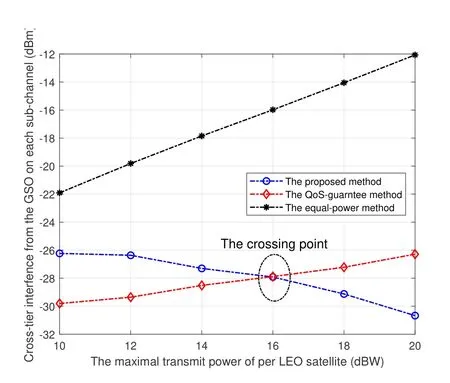
Figure 7.Cross-tier interference from GSO satellite to user terminals in each subchannel.
Figure 8 shows that the co-tier interference suffered in each subchannel from LEO satellites when maximum transmit power of LEO satellitesPs2increases from 10 dBW to 20 dBW,while the number of user terminals per LEON=10 and the number of LEO satellitesM=10.Figure 8 illustrates that the proposed method of co-tier channel gain at LEO satellites sites results in a lower co-tier interference than the QoS-guarantee method,and the co-tier interference will increase withP2sincreasing.Similar to the crosstier interference from GSO satellite,the proposed Lagrangian dual decomposition method is also suitable for the higher transmit powerPs2in terms of co-tier interference.
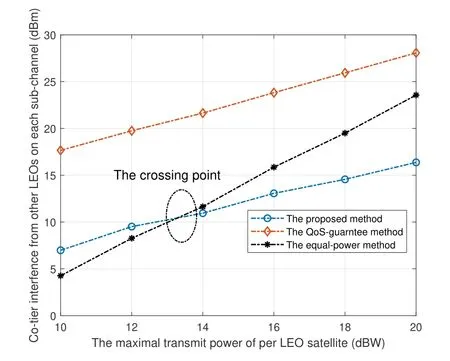
Figure 8.Co-tier interference from other LEO satellites to user terminals in each subchannel.
VI.OPEN ISSUES AND CHALLENGES
With the complementary use of satellite networks between and terrestrial networks,cognitive integrated terrestrial-satellite networks outperform most of traditional networks.However,there are still many open issues and challenges emerging from ultra dense satellite-enabled 6G networks.1) Deep sea or space scenarios: The high Doppler effect triggered by the presence of high-speed mobility and the cost of APs.2) The coordination of orbits among GSO satellites and other NGSO satellites.A much-anticipated scheme is required to coordinate the increasing connection of satellites,and advanced versions of this architecture are needed to involve more and more satellites in medium earth orbit,which suggest directions for future research.3) A unified standard of interference management between cognitive integrated terrestrial-satellite networks and traditional terrestrial networks.Multi-faceted factors are closely related to the interference in cognitive integrated terrestrial-satellite networks,which complicates interference management further.The implementation of unified standards is a massive leap to advance the next generation networks.
VII.CONCLUSION
The opening section of the paper lays out the deployment scenarios and the architecture of ultra dense satellite-enabled 6G heterogeneous networks.Complemented by each other,GSO satellites and LEO satellites system ensure the seamless communication on the ground,in cooperation with traditional cellular terrestrial networks.Grounded on the the current research,a three-layer caching deployment scheme combined with SMEC is highlighted.Additionally,resource optimization and interference management are conducted by convex optimization.Simulation results clearly verify the advantages of the proposed algorithms over existing algorithms.
ACKNOWLEDGEMENT
This work was supported in part by the National Key R&D Program of China(2020YFB1806103),the National Natural Science Foundation of China under Grant 62225103 and U22B2003,Beijing Natural Science Foundation(L212004),and China University Industry-University-Research Collaborative Innovation Fund(2021FNA05001).
- China Communications的其它文章
- Learning-Based Dynamic Connectivity Maintenance for UAV-Assisted D2D Multicast Communication
- AIGC Scenario Analysis and Research on Technology Roadmap of Internet Industry Application
- Dynamic Visible Light Positioning Based on Enhanced Visual Target Tracking
- Analysis and Optimization of Validation Procedure in Blockchain-Enhanced Wireless Resource Sharing and Transactions
- Anti-Jamming and Anti-Eavesdropping in A2G Communication System with Jittering UAV
- A Study of Ensemble Feature Selection and Adversarial Training for Malicious User Detection

